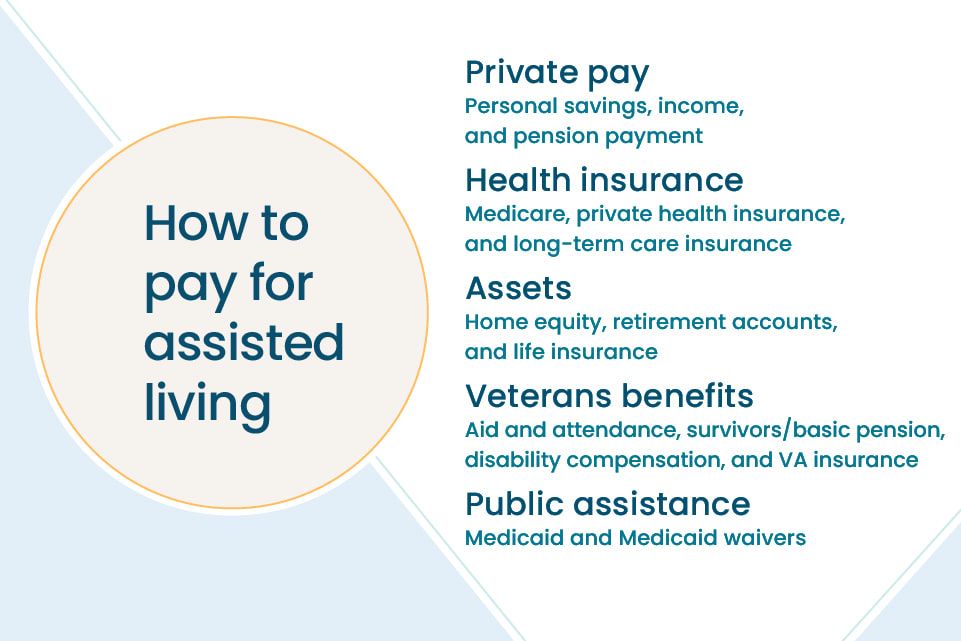
How to Pay for Assisted Living: A Comprehensive Guide

Making the decision to move to an assisted living community can be a much-needed change and a new chapter in your parent’s life. It’s also expensive, with a national median cost of more than $4,000 a month. Many families are disappointed to learn assisted living isn’t fully covered by Medicare, as they may not have that money in the bank. Luckily, seniors can pay for assisted living costs in several other ways, such as long-term care insurance, life insurance, home equity, and more.
Let our care assessment guide you
Our free tool provides options, advice, and next steps based on your unique situation.
Key Takeaways
- Many people rely on private funds for assisted living. This could include using personal savings, pension payments, or retirement accounts.
- Some people find other ways to use existing assets. This could include a reverse mortgage or selling a life insurance policy. Some people find other ways to use existing assets. This could include a reverse mortgage or selling a life insurance policy.
- Get creative to save on costs. You can ask communities about price flexibility or take advantage of tax credits. Get creative to save on costs. You can ask communities about price flexibility or take advantage of tax credits.
- Find assisted living that fits your budget. Narrow your search based on price range and other important community features. Find assisted living that fits your budget. Narrow your search based on price range and other important community features.
Who pays for assisted living?
Most families use private funds to pay for assisted living. This includes personal savings, pension payments, retirement accounts, or a combination of any of these. Though many seniors save for retirement over the years, family members often contribute to elder care costs.
Before choosing a community for your loved one, consider how you’ll pay for assisted living. Determine what funds are available through insurance, savings accounts, and family contributions. Once you have a rough idea of your budget, consider which features your parent prefers and how much care they’ll need.
Paying for assisted living: Where to start

The national median cost of assisted living in 2023 is $4,807 a month, according to A Place for Mom’s proprietary data.[01] Depending on where you live and the care needs of your loved one, you may pay less or more than that amount.
The median cost is an excellent starting point to keep in mind as you work on creating your budget. Even if the cost of living is low in your area, the cost of your loved one’s care might be more than you expect if they need a significant amount of hands-on assistance.
To determine a new resident’s level of care, the community conducts a care assessment. Some communities offer different levels of care at different prices or may offer a base care package that includes the option to add on additional care services. Should your loved one need more care over time, their monthly bill may increase. Planning for these changes now can save you from worrying over the cost later.

Let our care assessment guide you
Our free tool provides options, advice, and next steps based on your unique situation.
Private pay financing options for assisted living
Insurance, home equity, and other benefits can help cover the cost of assisted living.
1. Insurance
Older adults often rely on health insurance to cover medical procedures, hospital stays, and other care. Depending on your insurance policy, you may be able to claim some medical aspects of care.
| Payment option | How it works | Advantages | Drawbacks |
|---|---|---|---|
| Medicare | It may pay for the health-related aspects of care offered by an assisted living community. | You can claim things like medication management and insulin injections, which may be helpful for seniors with several medical needs. | You can’t claim assistance with personal care tasks such as bathing and dressing. Additionally, you may need to ask the community if they accept Medicare, and ask for an itemized monthly bill to submit claims. |
| Private health insurance | You may be able to submit claims to cover some skilled nursing health care costs. | As with Medicare, you can claim medically necessary care provided by the community. | You’ll need to contact the insurance company directly to determine what aspects of care they cover. Most providers don’t cover the cost of personal care assistance. You’ll also need to ask the community whether they accept private insurance. |
| Long-term care insurance | Most policies go into effect once the policy holder can no longer perform two activities of daily living. Your relative can then start to be reimbursed personal care assistance offered by their community. | This type of insurance covers assistance for bathing, dressing, and other tasks commonly offered in assisted living. | Your relative likely would’ve needed to purchase this insurance before the age of 60 and keep up with the ongoing monthly premiums, which are usually expensive. They’ll also need to consult their policy to make sure that care in an assisted living community is covered. |
2. Life insurance policies
Many people don’t realize that a senior’s life insurance policy, or that of a family member, can be used to pay for assisted living. You can sell a policy to a third party for market value and use the proceeds to fund a long-term care benefit plan while retaining some death benefits.
Another option is “surrendering” a life insurance policy to the life insurance company for cash value. In this case, you give up ownership and won’t receive any benefits upon death.[02]
3. Home equity
If your loved one owns a home or other property, they may be able to cover assisted living costs with home equity.
| Financing option | How it works | Advantages | Drawbacks |
|---|---|---|---|
| Bridge loan | This short-term loan is ideal for urgent situations and can help homeowners gain cash flow quickly. | This loan can be used to pay for assisted living while liquidating assets or waiting for the home to sell. | Someone will need to make payments on the loan until the house is sold. |
| Reverse mortgage | This option allows the borrower to tap into home equity and receive money as a lump sum or as needed to supplement income. | Depending on the lender and who is on the deed of the house, a senior’s spouse or adult children may be able to continue living in the home. | Unfortunately, many scams target seniors interested in reverse mortgages, making it that much more important to make sure you work with a reputable bank. |
| Selling or renting the home | Depending on how much money you need, selling or renting can increase your cash flow to pay for assisted living. | Although selling offers more cash up front, renting the home can also be a good option if your relative hasn’t decided what they ultimately want to do with the home. | Other family members may live in the house, or have a desire to keep the home in the family. Make sure to give everyone involved plenty of time for this adjustment. |
Using other benefits to fund assisted living
If your loved one served in the military, worked for the government, or was a railroad employee, they may be eligible for a stipend to cover some assisted living costs.
Wartime veterans and spouses may qualify for a pension program through the Department of Veterans Affairs (VA) to offset the cost of senior care. Our Guide to VA Benefits and Long-Term Care includes detailed information about how to apply, what’s included, and eligibility.
Federal and postal employees and annuitants, as well as qualified relatives, can apply for Federal Long Term Care Insurance (FLTCI), which helps pay for future long-term care expenses. Employees have to apply for FLTCI before retirement, and certain medical conditions may prevent approval.[03]

Talk with a Senior Living Advisor
Our advisors help 300,000 families each year find the right senior care for their loved ones.
Public pay: Using Medicaid for assisted living
Medicaid covers medical assisted living costs for qualifying low-income seniors. Medicaid is a state-regulated resource, so applying and qualifying — along with what’s covered — will vary from state to state. Not every assisted living community accepts Medicaid, though. If you can’t find a Medicaid-approved community, you may be able to apply for a waiver.
6 tips to stretch your assisted living budget
Even with the above benefits, senior care can be expensive. Discover how to pay less for assisted living with these six tips.
1. Ask about price flexibility and specials
Depending on the location and time of year, communities may be willing to offer a discount to fill vacant rooms. Many facilities offer deals at the end of the month or during seasons with lower move-in rates.
Ask these questions during your tour:
- Are there any move-in incentives?
- Do you have any specials available?
- Is the community willing to negotiate its monthly price?
- Can the entrance fee be waived?
- Can you offer a month free if we sign up for an extended lease?
- Are there any discounts available with lump-sum payments?
2. Compare a la carte costs with inclusive pricing
Some assisted living communities allow families to select either an all-inclusive rent fee or to pay for services individually based on need. Figuring out the best option for your needs will help you plan and budget more efficiently.
| Payment option | How it works | Advantages | Drawbacks |
|---|---|---|---|
| A la carte | This allows you to purchase services or items separately based on need, including laundry or bathing services, additional housekeeping, meal delivery, and more. | If your relatives have family members who live nearby and can commit to helping out with extra housekeeping or personal grooming, this option can save money in the long run. | If something unexpected happens and your loved one’s care needs increase, so will your payments. |
| All-inclusive | In this model, a monthly fee covers a range of services so there are no surprise costs. | If you’re expecting your relative’s care needs to increase over time, all-inclusive payments are often a better value. | Even communities with an all-inclusive model may have some services, such as meal delivery to your relative’s room, that aren’t included. Be sure to get a list of the included services. |
3. Consider a roommate
In many senior living communities, a shared space is more cost-effective than a single room or apartment. In addition to saving money, sharing a room can be safer and prevent loneliness, a common problem among older Americans. Many seniors do look forward to their own private space, so it’s best to look at this option if you think it would suit your loved one’s personality.
4. Enroll in discount programs for essentials for low-income seniors
Your loved one may be eligible to receive funds or assistance through senior benefit programs, allowing them to reallocate money normally spent on necessities to cover assisted living costs.
The National Council on Aging (NCOA) lists several benefits programs for vulnerable adults or low-income seniors to save costs on drug prescriptions, food, hearing care, dental care, vision coverage, and energy bills.
5. Save on moving expenses
Hiring a senior move manager can help cover downsizing and transition costs. Move managers may be able to help you determine the least expensive time to move, the best community options in your area, and how to sell possessions to help cover assisted living costs.
Most senior move managers partner with estate agents to help organize sales of personal collections, antiques, cars, and more. Many assisted living communities offer referral discounts for senior-specific relocation services.
6. Explore tax credits and deductions
One surprising way to recoup assisted living costs is through senior and caregiver tax credits. If your parent meets the IRS’s definition of “chronically ill” or needs help with two or more ADLs, they may qualify for medical tax deductions.[04] Relatives who pay for at least 50% of an elderly loved one’s care may also be eligible for caregiver tax credits.
Assisted living tips and resources
As you review communities, these tips and resources can help with every stage from budgeting to moving.
1. Create an assisted living budget
Once you review your loved one’s assets and what other family members are able to contribute, you’ll have a good idea of your assisted living budget. Collect information for each account, and gather it together into one document so you can clearly see all your payment sources, including retirement accounts, insurance policies, home equity, and family contributions. It might help to choose one account to draw from first while working on freeing up cash from other sources, such as selling a home.
When you’re creating your budget, keep in mind how long your loved one might be in their chosen community. Many factors determine how long a senior lives in a senior living community, but you can expect an average of two to three years of care.[05]
2. Compare communities easily with a touring checklist
As you tour communities, keep track of what you like about each of them with our Assisted Living Touring Checklist, which offers checkboxes for categories on a community’s staff, living units, amenities, and activities. This will make it easier for you to narrow down communities based on what amenities are most important for your loved one while sticking to your budget.
3. Plan for moving day
Moving day involves so much more than packing. A Place for Mom’s Moving Checklist offers an easy way to keep track of everything you need to make moving day as easy as possible for your loved one. From disconnecting old utilities to choosing furniture and clothes, you’ll have an easy view of all the important areas of your loved one’s life.
4. Seek expert advice and caregiver support
A Place for Mom’s Senior Living Advisors have experience helping families find affordable senior living. They can offer you community suggestions to fit your budget while providing your loved one with an enriching community to live in — all at no cost to your family.
You can also visit AgingCare’s Caregiver Forum to find out how other caregivers have handled care for their loved one. Sometimes, your best support can come from a group of others who are making the same decisions you are.
Key Takeaways
Recommended For You
A Place for Mom. (2022). Community room prices and fees.
Administration for Community Living. (2020, February 18). Using life insurance to pay for long-term care.
U.S. Office of Personnel Management. Federal long term care insurance program (FLTCIP).
IRS. (2022, January 13). Publication 502 (2021), Medical and Dental Expenses.
Administration for Community Living. (2020, February 18). How much care will you need?
The information contained on this page is for informational purposes only and is not intended to constitute medical, legal or financial advice or create a professional relationship between A Place for Mom and the reader. Always seek the advice of your health care provider, attorney or financial advisor with respect to any particular matter, and do not act or refrain from acting on the basis of anything you have read on this site. Links to third-party websites are only for the convenience of the reader; A Place for Mom does not endorse the contents of the third-party sites.
Make the best senior care decision
Make the best senior care decision